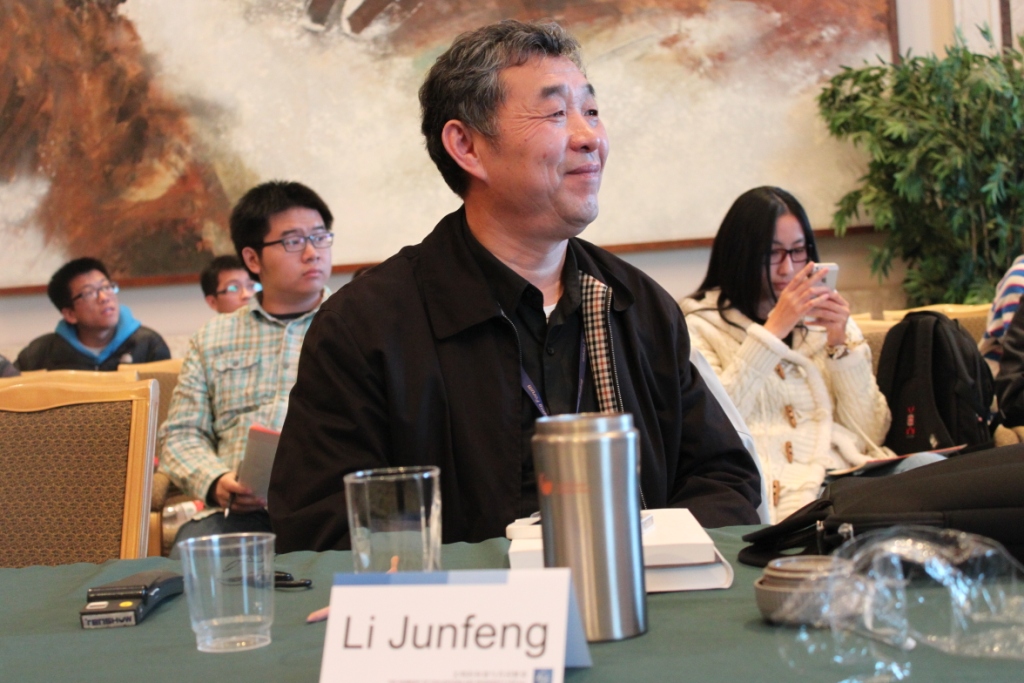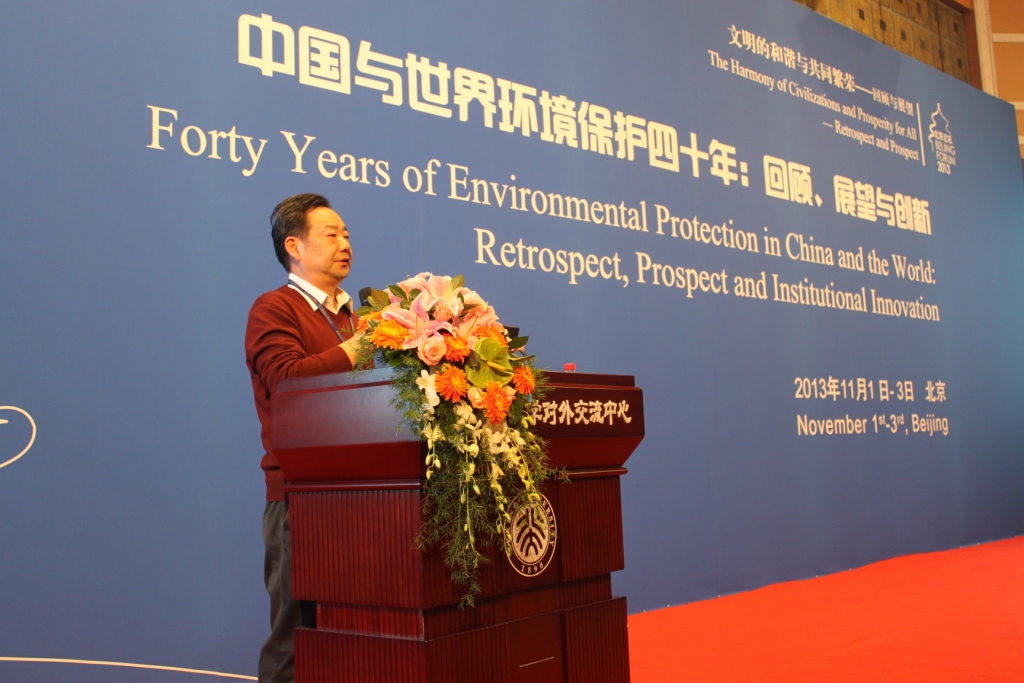
The third session of Beijing Forum (2013) Panel IV—“Forty Years of Environmental Protection in China and the World: Retrospect, Prospect and Institutional Innovation” was held at Sunlight Hall, Yingjie Exchange Center of Peking University on the afternoon of November 2nd2013.MsPeng Yan and Mr Jia Feng served as the chairs oftwo half sections of this session. Scholars from China and abroad took part in the discussions on the themes ofChina’s Environmental Challenges and Responds.
Professor Li Junfeng, who is the director of National Center for Climate Change Strategy and International Cooperation, made the first speech on the topic of "Green Development: Opportunities and Challenges for China". He strongly argues that China can only achieve the “green development” by having the courage to face the difficulties and challenges, by deep studies and understanding from a more systematic and integrated approach and the way of thinking, by the commitments to solve the real problems from bottom of heart, together with the practical and realistic action plans. His further emphasis on the fundamental basis of above is the belief and right concepts and attitudes towards environment. Mr Li stated that the rapid development of China’s economy and over-dependence on resource and environmental consumption has stimulated China’s economy into a dilemma characterized by “imbalanced, uncoordinated and unsustainable development”. To transforming from an unsustainable path to a more green economy, one should not only stress the reforming of legislation, regulatory system, right policy instruments, but also give attention to the behaviors changes and awareness improvement.

Figure 1. Professor Li Junfeng
Ms Li Lailai, the Director for WRI China, delivered her presentation on "Systems approach to urbanization and sustainable cities".She pointed out thatChina's biggest potential and challenges on environment for development in the coming decades lies in the process of urbanization. The core of urbanization should giveto improving the life quality and to deliverbenefits and wealth to people, especially farmers. To meet the challenges and avoid the possible failures on the eco-system conservation, anintensive, energy-saving and ecologically sounds development model can be the only way to help. Ms Li also indicated that such model can be realized by introducing“a new metaphor to take city as a system of entropy” in Thailand as a case, She explain this case about the factors of the success of the Thailand village, includes the community based management, the better use of local knowledge, and better and sustainable use of local natural endowment, especially to improve the sustainable livelihood of local people. She explained that the urban immigration is not necessarily the way to solve the problem, but rather find innovative urbanism to close the loop between cities and countries, so that the urbanization system will grow better and faster. Ms Li concluded her talk with a summary of indicators of sustainable urban development, includingsocial equity & quality of life, economic prosperityand environmental sustainability.
Dr. Sarah Liaofrom the University of Hong Kong who did not join the forum but delivered her papers and PPT focused on “Environmental Management in China: A Brief Review and Challenges Ahead” to the forum. In her view, the miracle of China’s growth was built upon a ‘carbon-intensive, get-rich-quick and clean-up-later’ kind of model. Dr. Sarah Liao give an overview of the major successes and failures in the 40-years’ environmental protection efforts in China with reference to the experience of the western developed countries. She stated that addressing many of China’s major environmental challenges entail participation of civil society groups and public participation as part of the environmental governance. She further pointed out that generating insight into development of a better balance between the environment, economy and society is critical for advancing the "green development" path in China.
Mr Roger Raufer, president of Raufer Ltd., delivered his talk on “Engineering to Economics, and Price quantity: Two environmental management transitions in China and the world”. He gave an detail explanation about the transition of environmental regulatory system from an engineering based approached to the economic and market based approach, and further from the price based to the quantity based and explore the underline reasons for the transition for dealing with pollution and environmental quality in China and around the world in the past forty years.. He addresses the advantages, possibility and problems related to China to apply the MBIs for controlling the pollution.The nature of these shifts is outlined in his view, along with reasons for their occurrence.Finally, he stressed thatChina is currently at the forefront of these transformations, given its severe environmental concerns while it remains to be seen whether the country will be able to provide the institutional support necessary for their success. While China has the institutional infrastructure necessary for implementation of these two transitions, it is not clear that if they have the necessary political will for the significant reductions required to address climate change concerns.
Professor Zhang Yuanhang from College of Environmental Science and Engineering of Peking University delivered his presentation on“Air Pollution Prevention and Perspective in China”. He first summarized evolution of air pollution feature in China from 1970s to the current stage, which from a coal combustion to a more complex of coal burning, vehicle emission, and from SO2, Acid Rain to a combination of the pollutions of SO2, Acid Rain, ozone, PM2.5 and VOC pollutants. He further gave an introduction and assessment about how China responding to the changes situation. Professor Zhang further use the Peking University’s study at Pearl River Delta as a case to explain more deeply about the mechanisms of pollutions formation and transformation, as well as how to base on the scientific findings to make the right decision to address the severe pollution problems. He gave an assessment about the air quality in this Delta and drawn the lessons to be learned and policy recommendations that a regional air pollution regime and science based decision making and right policy together with the enforcement to gain the Delta a more improved air quality than years ago.

Figure 2. Professor Zhang Yuanhang
At the turn of the century, how much impact will air pollution in China impose to the health conditions of the residents? Professor Zhu Tongfrom College of Environmental Science and Engineering at Peking University addressed this topic in his speech based on the studies of the team at Peking University. He gave an overview about the health impact studies and results conducted by researchers both in China and abroad, both on physical effects and social and economic impacts. And shared their research finding about how the PM2.5 impacts on human health based on their cohort and panel studies. At last, Professor Zhu pointed out that that there were three main epidemiological research methods: short-term exposure studies, panel studies and long-term exposure studies, though more long-term and comprehensive studies are needed, and he called the academic community and governments should pay more attention on health impacts in China.
Professor Eugene Y. Leong, who used to work for theAssociation of Bay Area Governments of theUnited States, shared his thoughts about air pollution control in San Francisco and Beijing, with a topic of “A 40 Year Tale of Two PollutedCities”. Dr Leong began his speech with the famous words from A Tale of Two Cities by Charles Dickens,and then talked about the process of 40-year atmospheric pollution control inSan Francisco to provide inspirations for current situation in Beijing. Two of the world’s premier regions are Beijing, China and San Francisco, California, USA. They share many similarities as economically vibrant economies, dynamic cosmopolitan urban centers, world class tourist destinations and strategic global trade centers. They also differ in an important area. The particulate air pollution, specifically PM2.5 levels, in Beijing are among the highest in the world, while the PM2.5 levels in San Francisco are among the lowest for highly populated urban areas. The San Francisco region once suffered from high levels of particulate and PM2.5 air pollution, especially during the late 1960s and 70s. After more than 40 years of comprehensive air pollution controls, however, the San Francisco region has much cleaner air. Beijing can also have much cleaner air and lower PM2.5 levels. This paper summarizes the lessons that can be learned from the San Francisco region to assist Beijing in achieving healthy PM2.5 levels for its residents. Finally, Dr Leong wrapped up his speech with a quote from his professor 40 years ago, “In trying to achieve too much too fast, we get too little,too late.” He suggested that improving air qualityneeded to “bewise, deliberate, aggressive, and steadfast and get it right.”
The last speaker isMsPengYan from C40Cities Climate Leadership Group and Clean Air Asia. She made speech on essenceof “Environment Protection – Reflections on Air quality Management” in thefollowing three aspects: focus of retrospect, questions for the future andprotect air with TRUST. She reviewed the experiences and lessons learned in US and China and made some comparisons. She emphasis on the air quality indicator should give enough considerations on health/or should be health related, which may imply the shift of pollution control strategies and the overall social cost and benefits. Ms Peng identified three barriers in the field of air quality management:1)long-term regional consulting mechanism is needed to boundary principles ofcooperation;2) environment-first principle prior to integrated economicand industrial plans is lacked; and 3)short of mechanism to guarantee mutual supplementin regional air quality management capacity. Aiming at overstep the above three barriers, Ms Peng suggest to implement low-carbon emission strategy with “TRUST”mode, process from bottom to up, consult on the basis of equality, protect the homeland together and train the air condition management troops for cities and regions systemically.
At the end of the session, Mr Jia Feng and Professor Zhang Shiqiu made the concluding remarks. They summarized the main academic opinions of the presentations and expressed their sincerely appreciation to all the speakers and working staff.